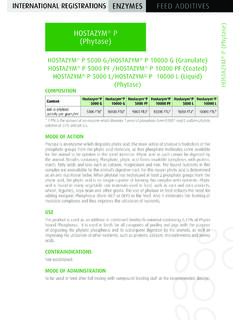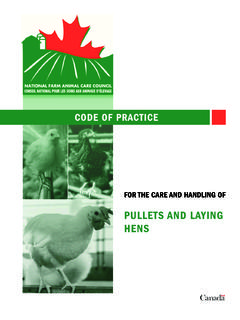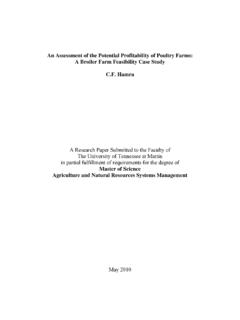Transcription of INDICATIONS - Biovet
1 EU registrations Veterinary products Pharmasin 100 mg/g and 250 mg/g Premix (tylosin). Pharmasin 100 mg/g and 250 mg/g Premix (tylosin). COMPOSITION. Content Pharmasin 100 Pharmasin 250. Tylosin 100 mg 250 mg Excipients: Wheat meal Dipotassium phosphate Up to 1 g Up to 1 g Pregelatinised starch (potato). PHARMACOLOGICAL ACTION. Tylosin is a macrolide antibiotic produced by a strain of Streptomyces fradiae. It exerts its antimicrobial effect by inhibiting protein synthesis of susceptible micro-organisms. The tylosin spectrum of activity includes Gram-positive bacteria, some Gram negative strains such as Pasteurella and Mycoplasma spp.
2 At concentrations of 16 g/ml or less. In most species peak plasma concentrations have been attained 1 to 2 hours after administration of tylosin. Compared to plasma levels clearly higher tissue concentrations have been observed. Tylosin was extensively metabolized. Most of the residues are excreted in faeces predominantly consisting of tylosin A, tylosin factor D and dihydrodesmycosin. INDICATIONS Pigs: Treatment and prevention of Porcine Intestinal Adenomatosis (Ileitis) associated with Lawsonia intracellularis when the disease has been diagnosed at the group or herd level, treatment and prevention of swine dysentery caused by Brachyspira hyodysenteriae when the disease has been diagnosed in the herd.
3 Broilers and pullets: Treatment and prevention of respiratory infections caused by Mycoplasma gallisepticum and Mycoplasma synoviae, when the disease has been diagnosed in the flock. Treatment and prevention of necrotic enteritis caused by Clostridium perfringens, when the disease has been diagnosed in the flock. Contraindications Do not use in animals with known sensitivity to the active substance and/or to any of the excipients of the veterinary medicinal products. Do not use in animals with known hyper sensitivity to tylosin and other macrolides. Do not use where cross-resistance to other macrolides (MLS-resistance) is suspected.
4 Do not use in animals vaccinated with tylosin-sensitive vaccines either at the same time or within 1 week previously. Do not use in animals with hepatic disorders. Do not use in horses. Veterinary products EU registrations Pharmasin 100 mg/g and 250 mg/g Premix (tylosin). MODE OF ADMINISTRATION. Orally, well homogenized into the feed. Pharmasin 100 mg/g premix: Administration through the feed: for the preparation of a medicated feed containing 40-200 gram tylosin per ton of feed, the required amount of Pharmasin 100 mg/g should be homogenously mixed with a suitable carrier into a feed premixture so that at least 5 kg of this premixture can be added to the feed in order to obtain amedicated feed with the required concentration.
5 As 1 kg Pharmasin 100 mg/g premix contains 100 g tylosin activity it follows that 10 mg Pharmasin 100 mg/g premix corresponds to 1 mg tylosin activity. Pharmasin 250 mg/g premix: Administration through the feed: for the preparation of a medicated feed containing 40-1100 gram tylosin per ton of feed, the required amount of Pharmasin 250 mg/g Premix should be homogenously mixed with a suitable carrier into a feed premixture so that at least 5 kg of this premixture can be added to the feed in order to obtain a medicated feed with the required concentration. For the preparation of medicated feed: As 1 kg Pharmasin 250 mg/g premix contains 250 g tylosin activity, it follows that 4 mg Pharmasin.
6 250mg/g premix corresponds to 1 mg tylosin activity. TARGET SPECIES. Pigs, broilers and pullets. DOSAGE. Treatment Product INDICATIONS Species Dosage active ingredient duration Porcine Intestinal 4-5 mg tylosin/ kg BW corresponding adenomatosis (PIA) to 40-50 mg Pharmasin 100 mg/g 3 weeks premix and to 16-20 mg Pharmasin . 250 mg/g premix per kg BW. Dysentery caused 4-5 mg tylosin per kg BW 4-5 weeks by Brachyspira or hyodysenteriae: 8-10 mg tylosin per kg BW 8 days Pigs (corresponding to 80-100 mg Pharmasin 100 mg/g premix and to 32-40 mg Pharmasin 250 mg/g premix per kg BW), Pharmasin 100. followed by 4-5 mg tylosin per kg BW until the end mg/g and 250.
7 Of the period mg/g premix of risk. 127 mg tylosin/kg BW corresponding to 1270 mg Pharmasin 100 mg/g Respiratory premix and to 508 mg Pharmasin 5 days infections 250 mg/g premix (repeat the Broilers treatment after 3-4 weeks and pullets 10-20 mg tylosin per kg BW. (corresponding to 100-200 mg Necrotic Enteritis Pharmasin 100 mg/g premix and 7 days to 40-80 mg Pharmasin 250 mg/g premix per kg BW). EU registrations Veterinary products Pharmasin 100 mg/g and 250 mg/g Premix (tylosin). For the preparation of the medicated feed the body weight of the animals to be treated and their actual daily feed consumption should be taken into due account.)
8 Consumption may vary depending on factors like age, breed, husbandry system. To provide the required amount of active substance in mg per kg mixed feed the following calculation should be made: mg Pharmasin 10% or 25%/ Premix average body weight (kg) of ..mg Pharmasin x 10% or 25 % premix kg BW/day the animals to be treated =. per kg/ mixed feed Average daily amount of mixed feed intake/kg per animal The mixing should be performed by an authorised feedingstuff manufacturer with adequate mixing apparatus. The uptake of medicated feed depends on the clinical condition of the animals. In order to obtain the correct dosage the concentration of tylosin should be adjusted accordingly.
9 Should there be no clear response to treatment within 3 days the treatment approach should be reconsidered. SIDE EFFECTS. In pigs, adverse reactions have been observed, including diarrhoea, pruritus, erythema, rectal oedema and prolapse. Tylosin has been shown to produce no adverse effects when fed to pigs at 600 ppm in the feed (three to six times the recommended dose level) for 28 days. At high levels diarrhoea, apathy, convulsions may occur. The therapy is symptomatic. WITHDRAWAL PERIOD. Meat & offal: Pigs: 0 day Broilers and pullets: 1 day Do not use in laying hens, producing eggs for human consumption.
10 STORAGE. Store in the original container to protect from light. Store in a dry place. Store below 30 C. Do not refrigerate or freeze. Protect from frost. PACKING. Low-density polyethylene/ paper paper paper bag of 5 and 20 kg with sutured crimp. 1 kg PE/Alu/PET bag. Not all packs may be marketed. Veterinary products EU registrations Pharmasin 100 mg/g and 250 mg/g Premix (tylosin). WARNING. Animals with acute infections may have a reduced feed intake and should be treated with a suitable injectable product first. Tylosin may induce irritation. Macrolides, such a tylosin, may also cause hypersensitivity (allergy) following injection, inhalation, ingestion or contact with skin or eye.








